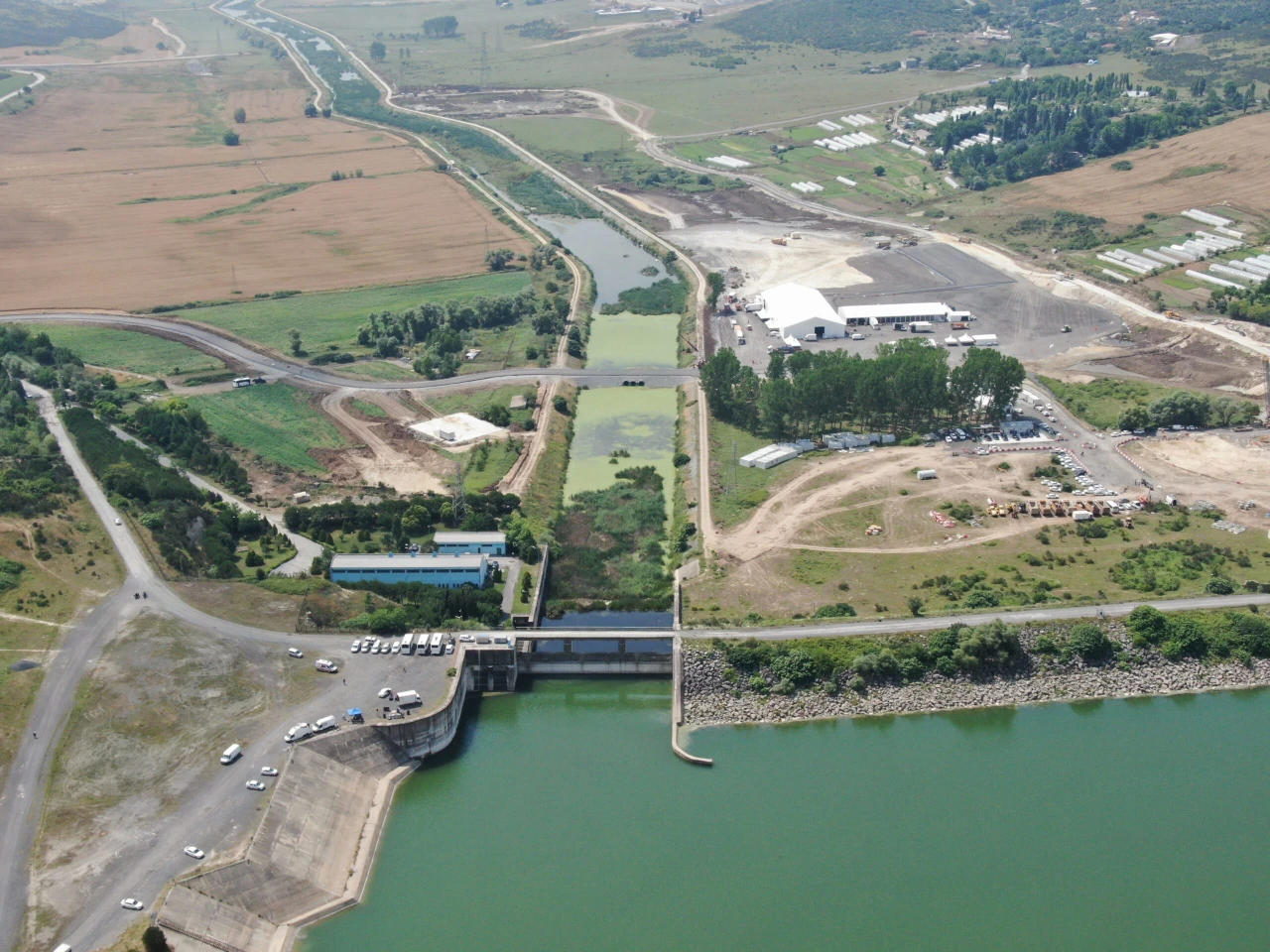War is looming: What is Hezbollah’s military capacity?
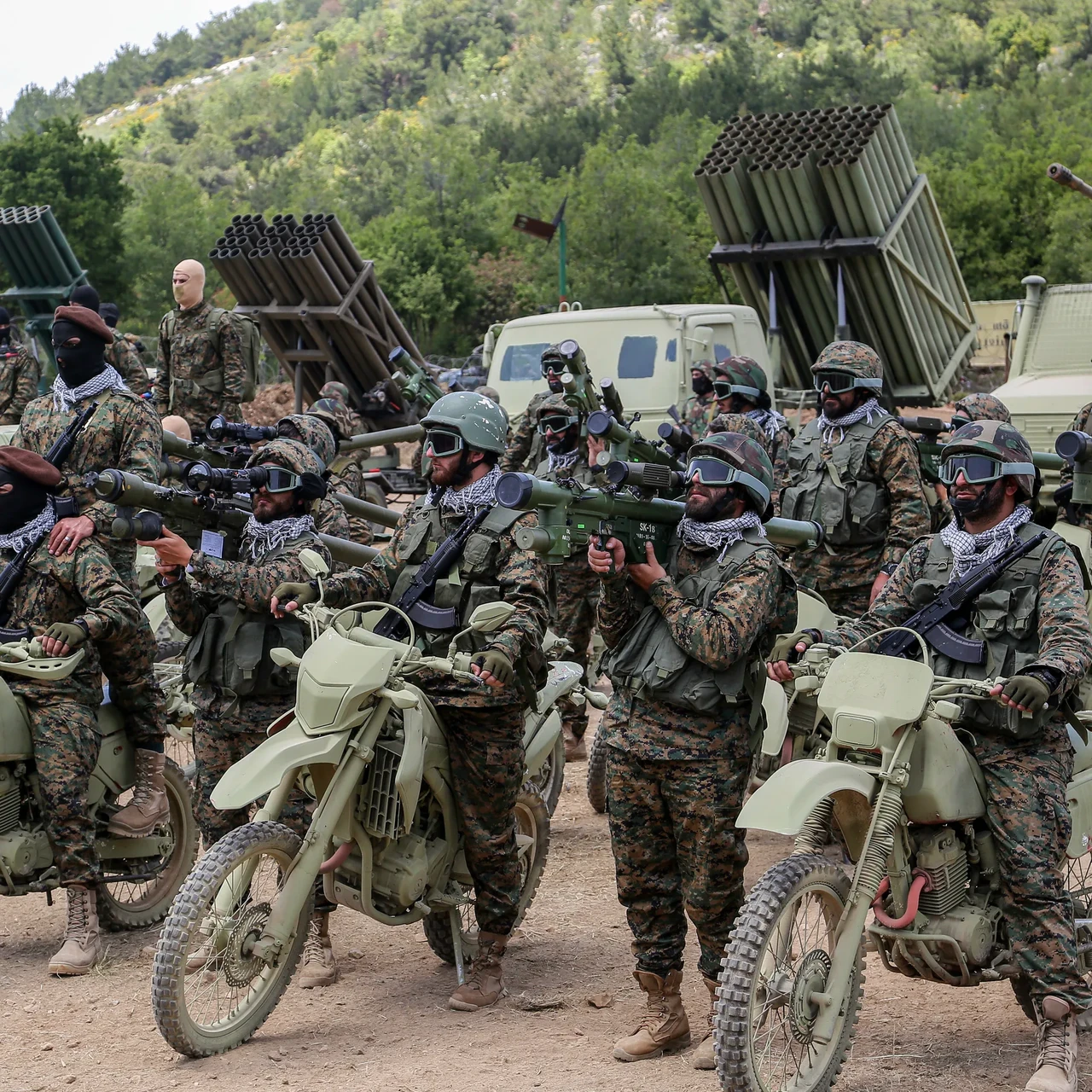 Pro-Iranian Hezbollah fighters take part in a staged military exercise in a camp in the Lebanese southern village of Aaramta on May 21. (Photo by Marwan Naamani via Getty Images)
Pro-Iranian Hezbollah fighters take part in a staged military exercise in a camp in the Lebanese southern village of Aaramta on May 21. (Photo by Marwan Naamani via Getty Images)
Hezbollah’s military capacity, which is expected to take part in the upcoming war, is a matter of curiosity. Hezbollah was founded in 1982 in the middle of Lebanon’s civil war – which raged for 15 years from 1975 to 1990.
Hezbollah, backed by Iran, is believed to possess over 150,000 missiles and rockets, according to the U.S. Central Intelligence Agency’s World Factbook.
The group asserts its rockets can strike anywhere in Israel. While many are unguided, Hezbollah also has precision-guided missiles, drones and various types of anti-tank, anti-aircraft and anti-ship missiles.
Iran is Hezbollah’s main benefactor and weapons supplier, providing a substantial portion of its arsenal, which includes Iranian, Russian and Chinese models.
In 2021, Hezbollah leader Sayyed Hassan Nasrallah claimed the group had 100,000 militants.
However, the CIA World Factbook estimated in 2022 that Hezbollah might have up to 45,000 militants, with about 20,000 being full-time. The number of militants might have risen since the last incidents in the region, especially the conflict in Gaza.
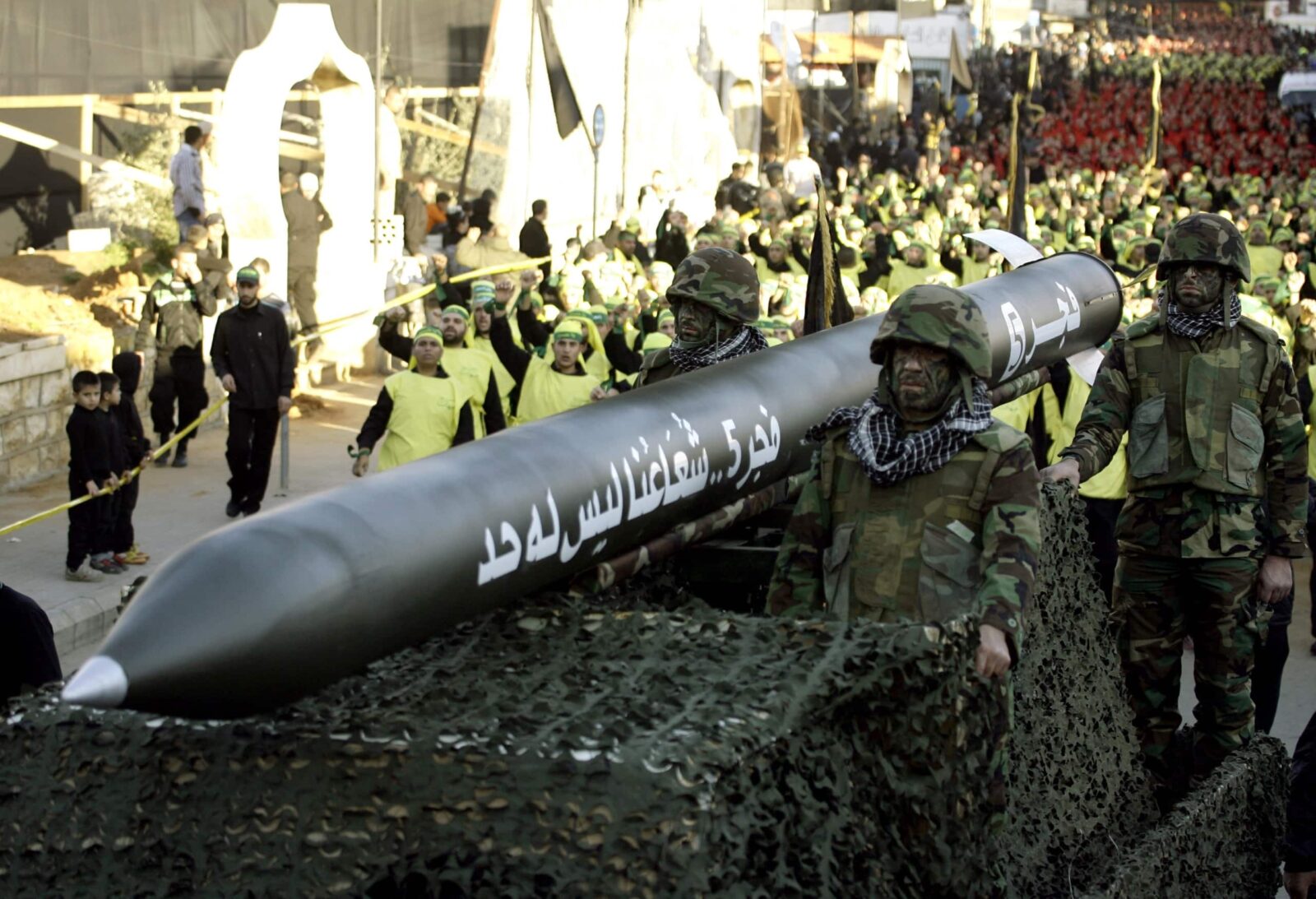
Rockets, missiles and more
Hezbollah’s rockets and missiles pose significant threats to Israel. Continuous barrages can penetrate the Israeli air defense systems. Additionally, these systems can suppress or attack IDF forces, limiting the effectiveness of Israeli operations.
Estimates suggest Hezbollah possesses between 120,000 to 200,000 rockets and missiles. Its close relationship with Iran ensures a steady resupply if needed, facilitated by Iran’s expanded presence in Syria – creating a land bridge for weapons transfer.
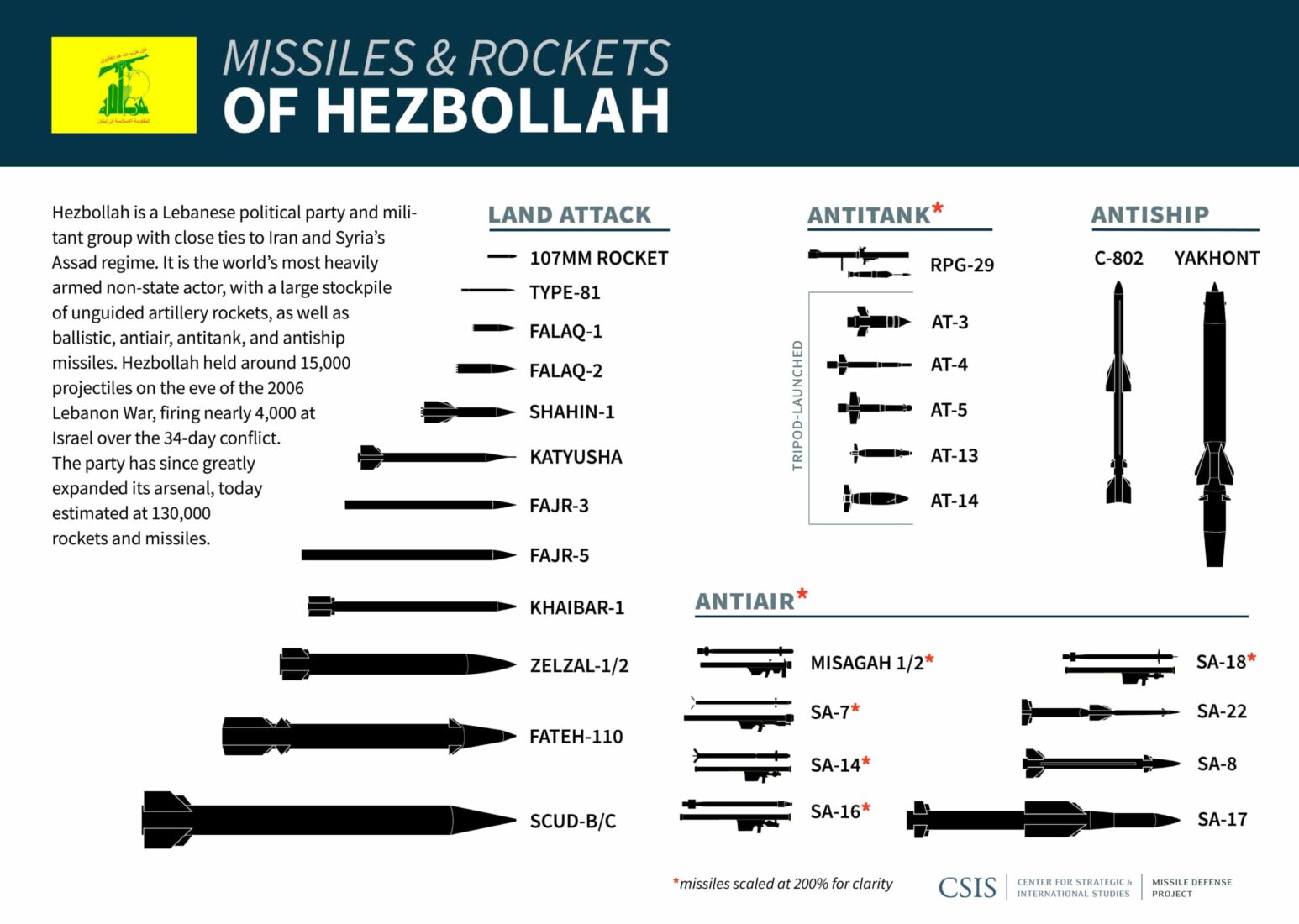
- 107 & 122 mm ‘Katyusha’ Rockets: The term “Katyusha,” originally used by Soviet soldiers in World War II for 82 mm and 132 mm rockets, now refers to most of Hezbollah’s unguided artillery rockets. Hezbollah’s Katyusha models vary by range (4-40 kilometers), warhead (10-20 kilograms, high explosive or submunitions), and launch weight (45-75 kilograms). The 122 mm 9M22 Grad-type, with a range of 20 kilometers (24.8 miles) and a 6-kilogram (13.2 pounds) warhead, is a notable variant, fired from tripods or truck-based launchers. Katyushas form the bulk of Hezbollah’s rocket force and were heavily used in the 2006 Lebanon War. By 2006, Hezbollah was estimated to have 7,000-8,000 Katyusha rockets, with numbers increased since. Iran, their primary supplier, has provided truck-mounted launchers since 2001, allowing for salvo attacks.
- Fajr-1 / Chinese 107 mm Rockets: In the 1960s, China developed 107 mm artillery rockets for its Type-63 multiple rocket launcher (MRL). China sold these rockets to Syria and 500-700 units to Iran, which then created indigenous copies named Fajr-1 for the rocket and Haseb for the MRL. Iran supplied Hezbollah with around 144 Haseb-type launchers and an unspecified number of rockets. These rockets have a range of 8-10 kilometers and carry an 8-kilogram high explosive fragmentation warhead. They vary in length from 0.841 meters to 0.92 meters and weigh around 19 kilograms.
- Falaq 1/2: The Falaq, also known as Falagh, is a family of unguided surface-to-surface rockets developed by Iran in the 1990s. The Falaq-1 has a range of 10-11 kilometers and carries a 50-kilogram high explosive (HE) warhead. The Falaq-2, also with a 10-11 kilometers range, carries a 120-kilogram HE warhead. On August 25, 2005, Hezbollah ‘accidentally’ fired a Falaq-1 into Israel and later used Falaq rockets during the 2006 second Lebanon War.
- 333 mm Shahin-1: The Shahin-1 is a heavy artillery rocket developed by Iran, featuring an unguided design. It has a range of 13 kilometers and carries a 190-kilogram high explosive (HE) warhead.
- 122 mm Type-81 Rocket: Hezbollah’s Type-81 rocket, an enhanced-range 122 mm variant, falls under the Katyusha category. It has a range of 20.5 kilometers with a high explosive (HE) warhead, reportedly carrying 39 MZD-2 or Type-90 submunitions.
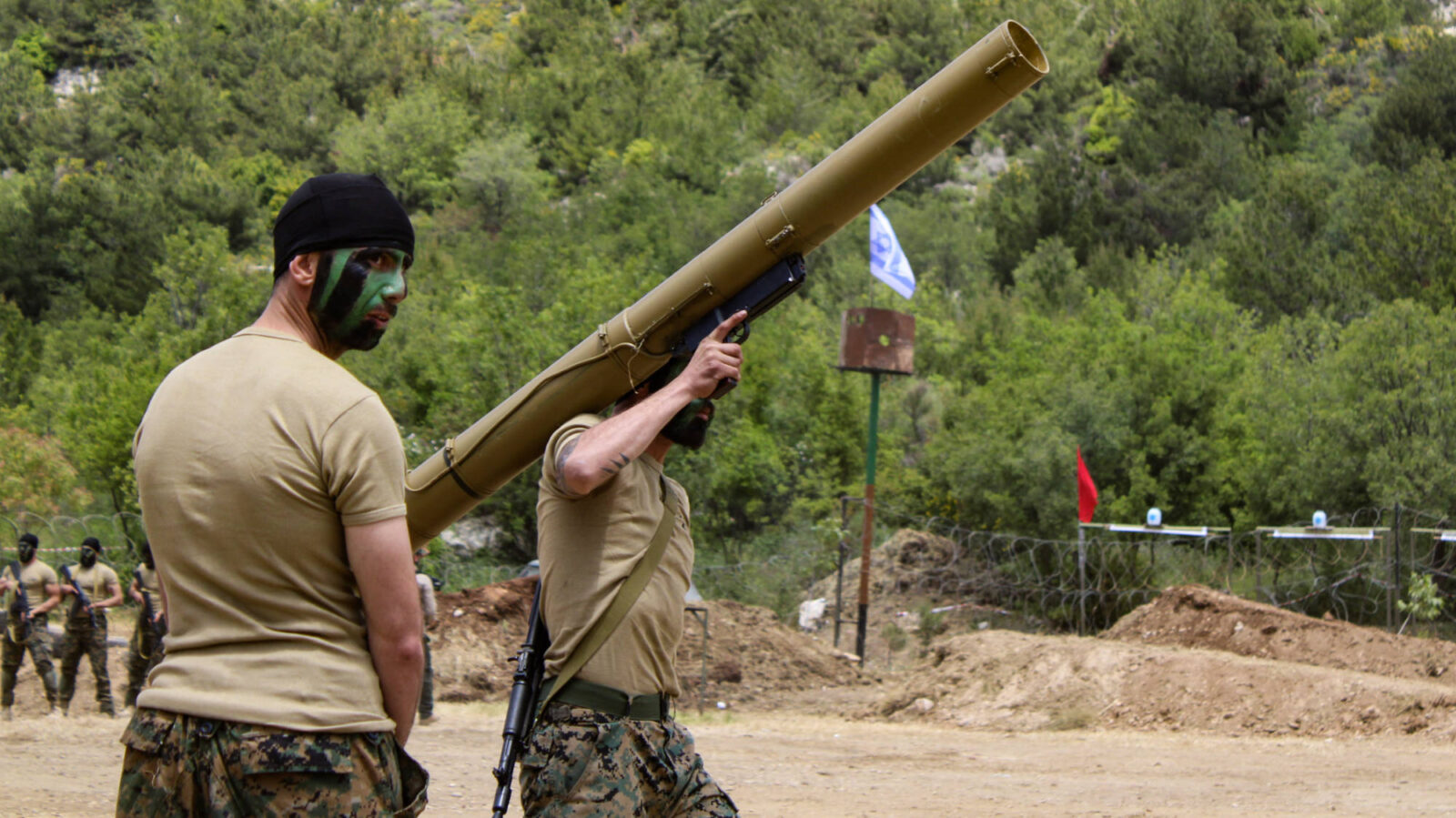
- Fajr-3 and Fajr-5: The Fajr is a family of unguided surface-to-surface rockets developed by Iran in the 1990s. By 2011, the IDF estimated Hezbollah’s stockpile at several hundred of these rockets, probably we must be talking about thousands of these rockets. The Fajr-3 has a range of 43 kilometers and carries a 45 kg high explosive (HE) warhead. Fajr-5 has a range of 75 kilometers with a 90-kilogram HE warhead. In the early 2000s, Israeli intelligence reported that Fajr rockets were distributed to core Hezbollah members. Hezbollah first fired a Fajr-5 during the 2006 Lebanon War.
- Raad-2 and Raad-3 / 220 mm Uragan-type Rockets: The Soviet Union sold Uragan rockets and launcher systems to Syria, which then transferred a number of these rockets to Hezbollah in the early 2000s. The Soviet Union designed these artillery rockets in the 1970s for its BM-27 ‘Uragan’ multiple rocket launcher (MRL). Renamed by Hezbollah as the Raad-2 and Raad-3, these rockets have a range of 60-70 kilometers with a 50-kilogram high explosive (HE) warhead.
- 302 mm Khaibar-1 / M-302 / B-302: The Khaibar-1 rocket is an unguided artillery rocket, developed and manufactured by Syria. Reports suggest the Khaibar-1 is based heavily on the Chinese Wei Shi (WS-1) MRL system. The Khaibar-1 has a range of 100 kilometers while carrying a 150-kilogram payload. It is typically equipped with large, anti-personnel warheads.
- Zelzal-1 and Zelzal-2: The Zelzal is an Iranian variant of the Soviet FROG 7 artillery ballistic missile. The Zelzal-1 has a range of 125-160 kilometers while carrying a 600-kilogram high explosive (HE) warhead.
- Fateh-110 / M-600: The Fateh-110 is an Iranian short-range, road-mobile ballistic missile. It is most likely a modified version of the unguided Zelzal-2, with the addition of control and guidance systems. The Fateh-110 and M-600 have ranges of 250-300 kilometers, making them among the longest-ranged weapons in Hezbollah’s inventory. Both missiles carry a 450-500 kilograms high explosive (HE) warhead and are GPS-guided, providing them with a CEP of 500 meters.
- Scud-B/C/D: Unconfirmed reports indicate Syria transferred an unknown number of Scud missiles (B, C, and/or D variants) to Hezbollah. These reports emerged in late 2009, and again in April 2010 when then-Israeli President Shimon Peres directly accused Syria of transferring Scuds to Hezbollah. Neither Israel nor the United States, however, have provided any evidence that Hezbollah is or ever has owned Scuds.
- Antiship Missiles (ASMs): C-802 / Yingji-2 / Noor: The C-802 is a medium-range antiship cruise missile (ASCM) developed by China in the 1970s-1980s. Iran began buying dozens from the Chinese during the 1990s until the United States pressured Beijing to cease sales. Iran then developed its own variant, the “Noor”, and transferred it to Hezbollah.
- Yakhont: Russia delivered 72 Yakhont coastal defense missiles to Syria in December 2011, along with 18 TEL vehicles. Additional shipments of more advanced, radar-equipped variants followed in May 2013. Syria transferred a number of these systems to Hezbollah. As of January 2016, the United States estimates that Hezbollah possesses up to 12 Yakhont ASCMs.
Hezbollah’s experience in the Syrian conflict has enhanced its capabilities. The group can now conduct coordinated maneuvers, employ suppressive artillery, and manage logistics for larger forces. It has also acquired T-72, T-54/-55, and T-62 main battle tanks, though their effective use within Lebanon is questionable because of sustainment challenges and the threat of Israeli airstrikes.
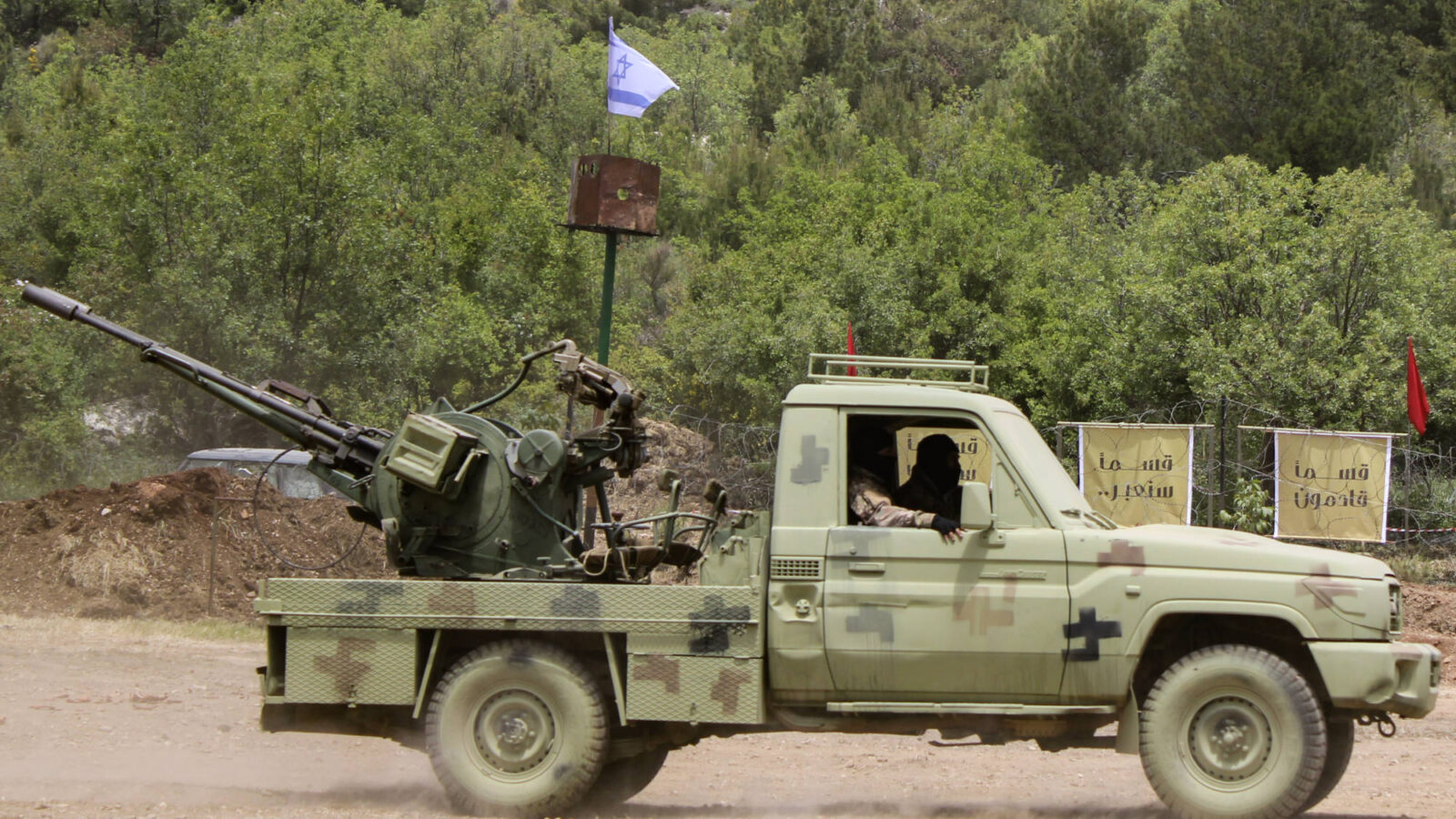
Anti-tank Missiles (ATMs)
- RPG-29 Vampir: The RPG-29 is an unguided rocket-propelled grenade launcher (RPG) developed by the Soviet Union in the 1980s.
- 9M14 Malyutka (NATO: AT-3 Sagger): Hezbollah is estimated to hold hundreds of Iran- and Syria-supplied AT-3s. It has an effective range of up to 3 kilometers while carrying a 2.6 or 3.5 kilograms warhead.
- 9K111 Fagot (NATO: AT-4 Spigot): Hezbollah is estimated to hold hundreds of Syria-supplied AT-4s. The second-generation ATGM has an effective range of up to 2.5 kilometers and can penetrate armor up to 480 mm thick.
- 9M113 Konkurs (NATO: AT-5 Spandrel): An Israeli report suggests that Iran provided Hezbollah with domestic copies of the AT-5. The AT-5 has an effective range of 4 kilometers and armor penetration of over 750 mm.
- 9K115-2 Metis-M (NATO: AT-13 Saxhorn-2): Russia sold the AT-13 to Syria, which then provided the weapons to Hezbollah in the early 2000s. Hezbollah is estimated to hold hundreds of AT-13s. It has an effective range of 1.5 kilometers.
- 9M133 Kornet-E (NATO: AT-14 Spriggan): Russia sold the AT-14 to Syria between 1990-1999, which provided hundreds to Hezbollah soon thereafter.
- The Almas: The Almas missile family is a product of reverse engineering, based on the Israeli Spike missile family, which was designed and manufactured by Rafael. Almas 1, Almas 2 and Almas 3. Each version presents an upgrade in the missile’s range, warhead, performance and guidance systems. The different versions are equipped with an advanced tandem anti-tank warhead, allowing for deep armor penetration.
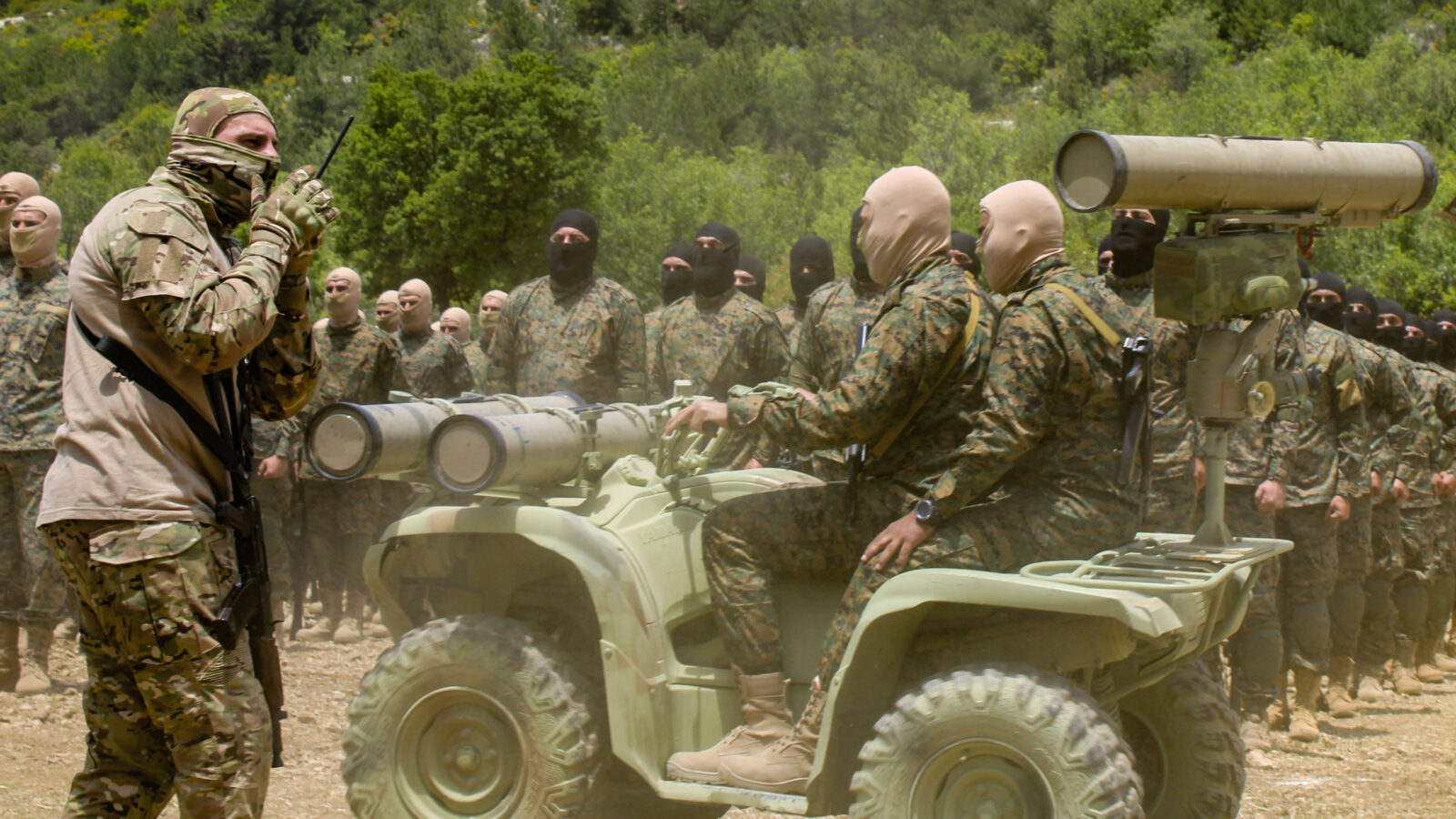
Geography, defensive positions
The geography of southern Lebanon provides several advantages that Hezbollah fighters could use in a war with Israel. The region’s rocky hills and varied terrain allow small and mobile groups to conceal their movements and launch attacks.
Hezbollah has constructed a network of tunnels and bunkers to securely move equipment and personnel and to launch ambushes and rocket attacks. Rivers such as the Litani River serve as natural defensive fortifications, controlling movement and offering tactical advantages in combat.
Anti-air missiles (AAMs)
Hezbollah’s air defenses could force Israeli aircraft to fly at higher altitudes, reducing their operational capability. On February 26, 2024, the IDF struck Hezbollah’s air defense sites in the Beqaa Valley after Hezbollah shot down an Israeli drone.
Hezbollah’s tactical proficiency, combat experience, and willingness to fight make it a powerful organization, surpassing even regional militaries like Hamas.
Hezbollah is larger, better armed and more experienced, designed for coercive military campaigns against Israeli forces using rockets, long-range missiles, anti-tank guided missiles (ATGMs) and UASs. While it can conduct combined arms offensives, it remains technologically outmatched compared to Israel.
- Misagh-1/2: The Misagh-1 is a second-generation, man-portable anti-air missile (MANPAD) developed by Iran in 1994.
- ZU-23: The ZU-23 is a stationary unit with twin 23 mm anti-aircraft guns developed by the Soviet Union in the 1950s. It was designed to engage low-flying targets at a range of 2.5 kilometers and a maximum altitude of 1.5 to 2 kilometers.
- 9K32 Strela-2 (NATO: SA-7 Grail): The SA-7 is a man-portable anti-air missile (MANPAD) developed by the Soviet Union in the 1960s. The SA-7 can engage targets between 0.8 to 3.4 kilometers away, at a maximum altitude of 1.5-2.3 kilometers.
- 9K33 Osa (NATO: SA-8 Gecko): The SA-8 is a tactical air defense system developed by the Soviet Union in 1972, and modified several times since.
- 9K34 Strela-3 (NATO: SA-14 Gremlin): The SA-14 is a man-portable anti-air missile (MANPAD) developed by the Soviet Union in the 1960s and 1970s. It was largely based on the earlier Strela-2 and -2M. The SA-14 can engage targets between 0.5 and 4.5 kilometers at a maximum altitude of 1.5 to 3 kilometers.
- 9K310 Igla-1 (NATO: SA-16 Gimlet) and 9K38 Igla (NATO: SA-18 Grouse): The SA-16 and SA-18 are man-portable anti-air missiles (MANPAD) developed by Russia. The SA-18 is an improved version of the SA-16. The rockets have a range of about 0.5 kilometers, a flight ceiling of 3.5 kilometers, and employ a two-color infrared homing device for guidance. They were most likely supplied by Iran.
- 9K40 Buk-M2 (NATO: SA-17 Grizzly): The SA-17 is a medium-range air defense system developed by Russia in the early 1990s. It holds four ready-to-launch missiles, which can engage targets at a 50-kilometer range at an altitude of 10 to 24 kilometers.
- Pantsyr-S1 (NATO: SA-22 Greyhound): The SA-22 is a short- to medium-range air defense system developed by Russia in the 1990s. Iran or Syria likely supplied Hezbollah with the system. Russia sold Syria 850 Pantsyr-S1E units in 2008 and 36 units of the Pantsyr-S1E in 2009. Russia also sold Iran 10 units of the Pantsyr-S1 at an unknown time. At a United Nations meeting in 2015, Israeli Prime Minister Benjamin Netanyahu accused Iran of transferring SA-22s to Hezbollah; however, Israel did not substantiate these claims.
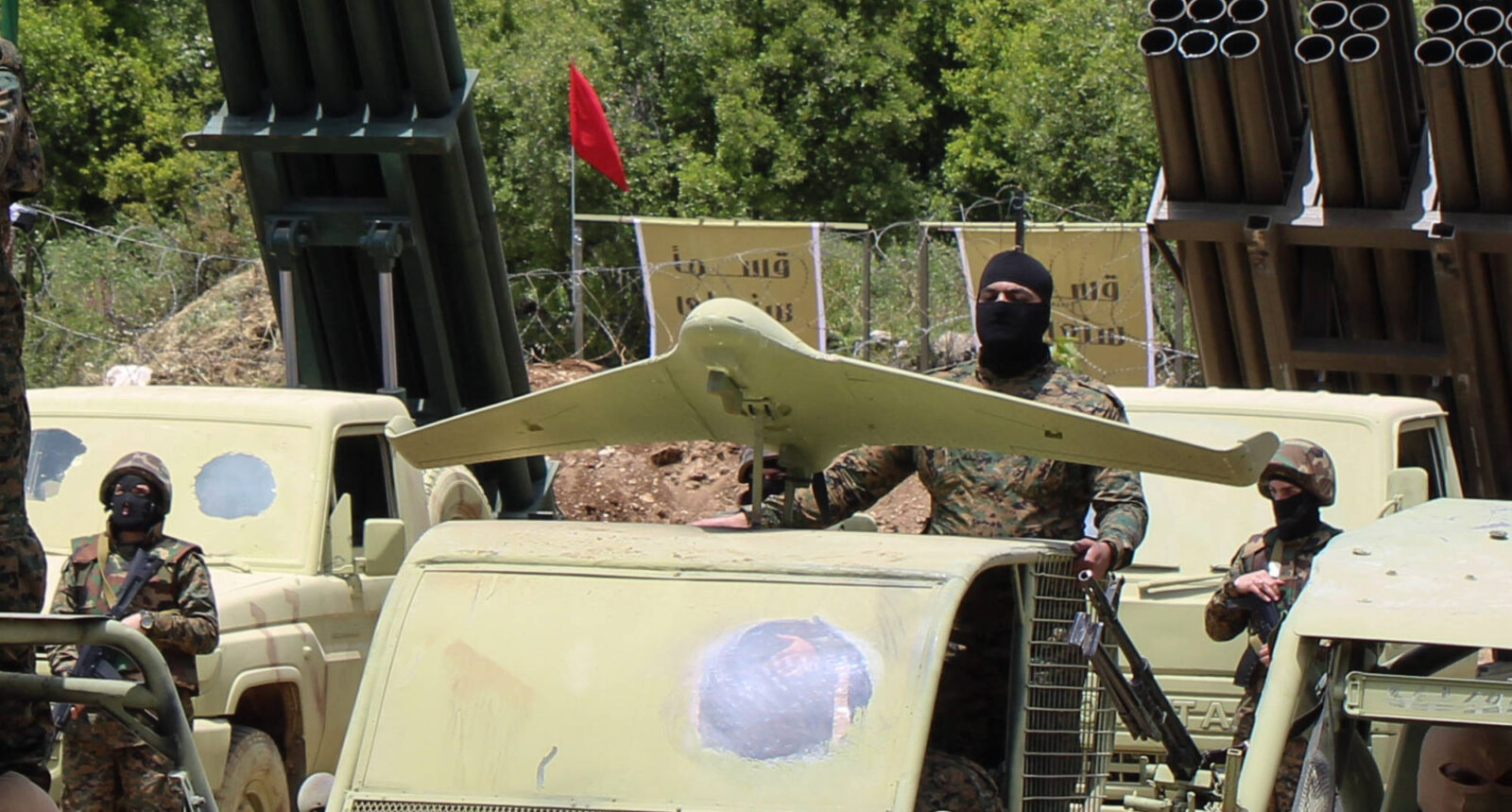
Since Oct.7, Hezbollah has attempted at least 40 Unmanned Aircraft System (UAS) attacks against Israeli targets. Several of these attacks have successfully penetrated Israeli air defense systems, killing IDF soldiers and damaging military sites in precision strikes.
Hezbollah holds various types of UAS systems in its inventory, including the ones that are developed by Iran, used as kamikaze drones.
Hezbollah UAS systems come in a wide variety. This list is not exhaustive and Hezbollah likely possesses additional Iranian or indigenous drone models.
Also not shown are the variety of commercial drones, such as Chinese DJI quadcopters, that Hezbollah possesses and which can be used to conduct surveillance or modified to deliver explosive payloads as we have seen footages similar of them being used that way in the Oct. 7 attack by the Hamas.
Tensions in the region are increasing day by day.
It is stated that Iran will retaliate, and in the event of a full-scale regional war, difficult times await civilians living in the region.
